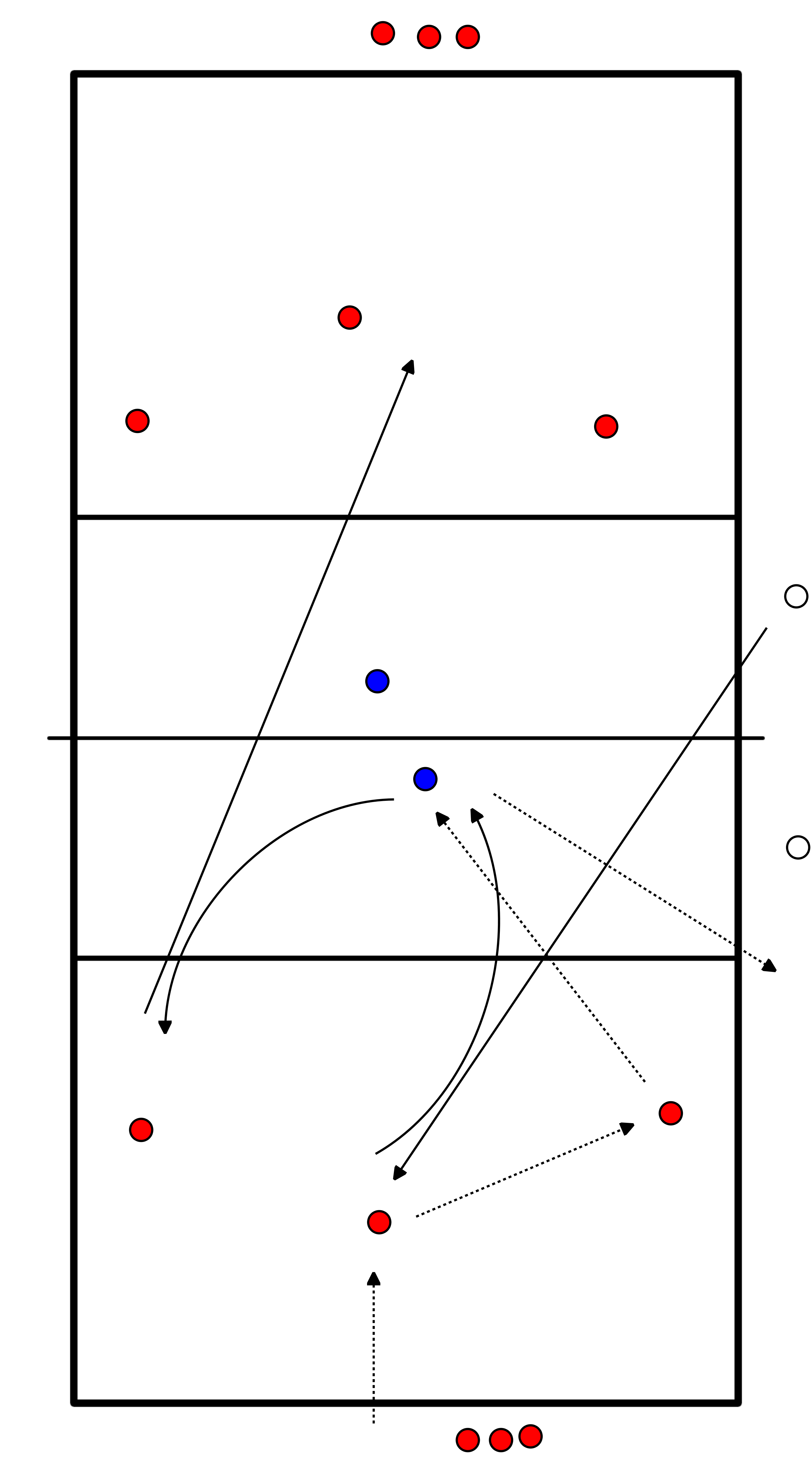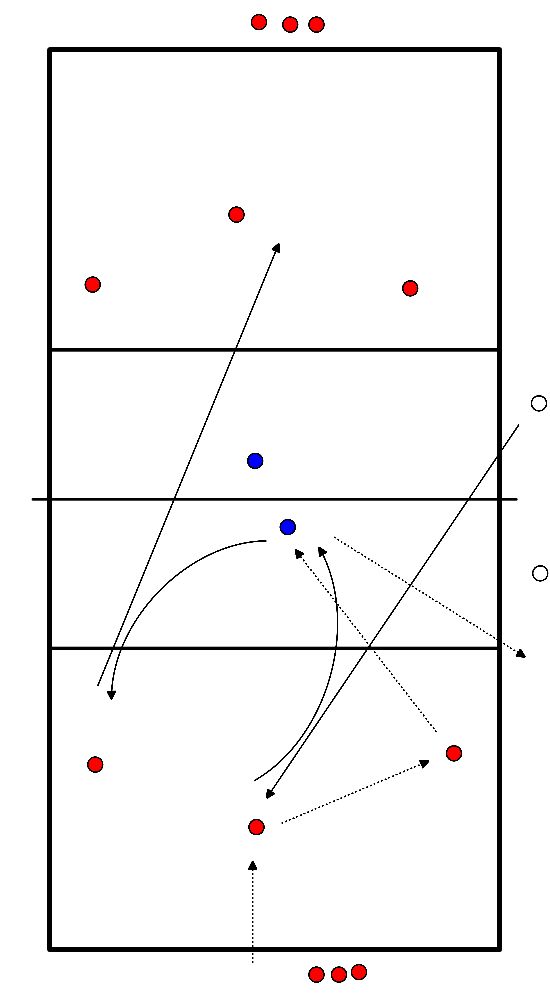Volleyball drills
BALBAGE :
- Two teams of at least 5 people
- Trainer (white sideline) throws ball on the MA (position 6)
- Pass to playmaker
- Distributor gives high ball to left front and right front near the 3 meter line
- Attack on 3 meter
- Opponent defends the ball and builds up a new attack in the same way, if not defended, trainer throws in a ball
LOOP DIRECTION:
- Defender (mid-back) takes place of attacker (left or right)
- Attacker goes to position MV (position 3)
- MV runs out of the field and joins group on back line


- 5 laps around the terrain
- Walking around the field, arms swinging loosely
- hands together and loosen wrists.
- Hopping on left foot over and over the terrain, then right foot. 2x
- Sideways up and down 3x
- Up and down with big jumps. 2x
- Sprint up and down the field 2x
- idem but leave lying on belly 2x
- idem but leave lying on back 2x
- Lie down next to each other on the sideline. (10 x push-ups, 10 x set-up, 10 x oblique abdominals)
relay:
- 2 groups behind the back line.
- The front players roll the ball,
- run after it and pick it up behind the 3-meter-line,
- come back and give the ball to the next player.
- idem:
- But now run with the ball up to the 3-metre line,
- then throw the ball into the net and catch it again.
- Then run back and give the ball to the next player.
- idem
- But now run with the ball to the net,
- With shoulder to the net, throw the ball over,
- Pass the ball sideways under the net, catch it and pass it again,
- Back to the side under the net,
- Repeat this again
- And then hand the ball over to the next player. (Ball goes over the net 4 times per person).
- One player per group starts with ball on the other side of the net on the 3-meter line to throw balls.
- The first one of the group runs in and gets the ball at the net.
- He passes it back and catches the ball himself at the other side of the net.
- The thrower passes under the net and runs back to the back line.
- The next player may then leave.
- Same but now play back underhand
- 10x pumping
- 20 setups
- 20 lunches
- 10 squats (with bounce)
- 30 sec plank
- 20 side tube muscles (foot tapping in the air)
- 10 jump squat
- 30 sec side plank
- Skip two teams overhead
- start at the net
- then circle the field.
- Bunch of two balls
- one sits on his knees on the ground the other goes from left to right
- after a while change
- Both sides set up a team, normal game line-up.
- Trainer throws ball into the backfield, team defends and builds up attack, opponent idem, ball is introduced by trainer where mistake is made.
- Quick switching, lasting rallies and no delays as a result of service.
- Regularly turn at the indication of the coach.
Trainer stands with ball box at the net, position 2/3, players stand at position 1, 5 and 6 for defense.
Trainer throws ball to players:
- If ball at position 1, players of position 1 and 6 exchange after playing back ball
- If ball at position 6, players remain standing
- If ball at position 5, players of position 5 and 6 clear after playing back ball
- As long as the passing remains good at 2/3, the coach continues to pass the ball.
- Players not participating stand around the field and make sure the ball pit stays filled.
- We make a square of benches with +/- 15 balls in it.
- 2 players go into the square and the rest of the players stand around it.
- The players in the square get 60 seconds to throw as many balls as possible out of the square, it is up to the other players to throw as many balls back into the square.
- After the 60 seconds the balls in the square are counted and then it's up to the next 2 players.
- (In between there is a rest period of about 60 seconds).
- The duo that has the least balls in the square at the end has won.
- The others do a punishment (for example clean up the balls and the benches.
- 5 (or minus 4) players per side of the field, with 1 ball.
- 4 players stand in the field and 1 player stands at the back line with the ball.
- The 4 players in the field are lined up and the player at the back line of the other side is going to pass the ball over the net (overhand or underhand does not matter for this exercise, but the ball must be over the net!)
- The players are going to defend this ball to the player who gives the pass (this one is run in from position 1).
- This player catches the ball above his head and gives a high pass.
- The ball is caught at the net (no attacking).
- The ball then goes to the server.
- The same exercise is done but now with the other side of the court. After this it is back to the first side to serve.
- So there is one place rotated.
- After a while the same exercise can be done with an attack (key over the net) where it is important that when the attack is done over the net player 1 and 3 exchange places!!!!!!!
- All players take a ball (except 2 players).
- The 2 players without the ball both stand in the middle on one side of the net.
- The other players all line up at position 4,
- the first player throws his ball/or touches in a good intention towards the player who gives the pass.
- The first player throws his ball/or key in a good intention to the player who gives the pass.
- The ball is caught and this player continues to the other side of the net.
- This player does the same while the second player can already set up at the first pass.
- When all players have been through both passeurs they will be exchanged.
- Until everyone has passed. (If this works well after a few practice sessions, you can then build up to a possible attack as well!)
- The group is divided into pairs.
- They stand in front of each other in pump-up position.
- They do handshake
- right/right, left/left
- high five right/left, left/right








